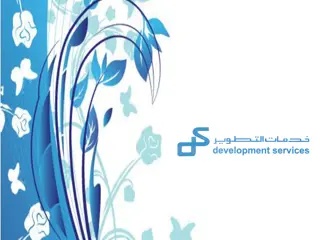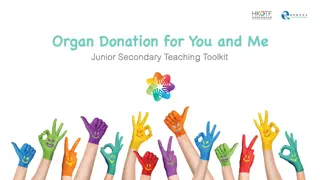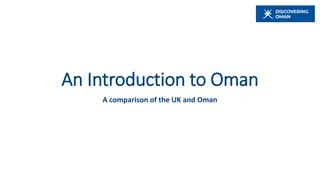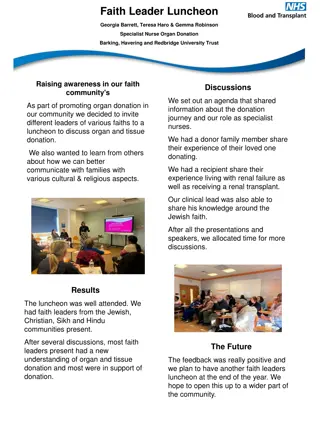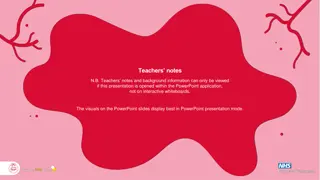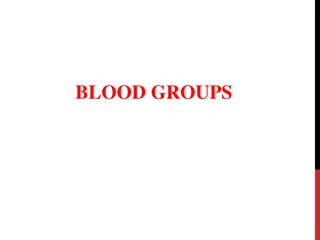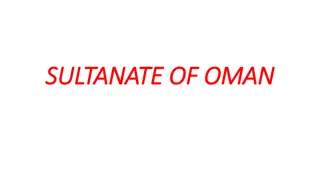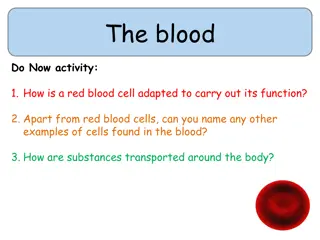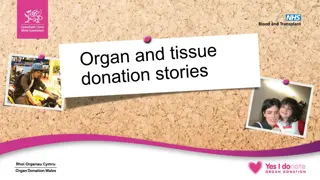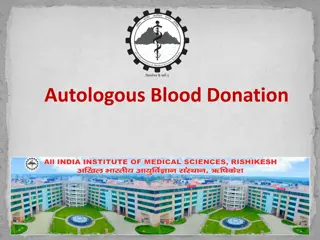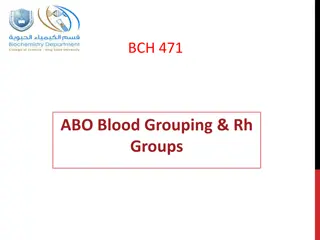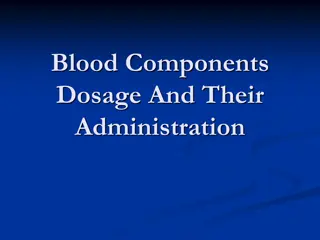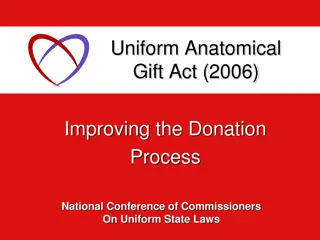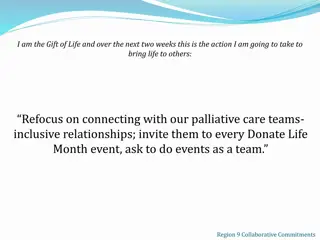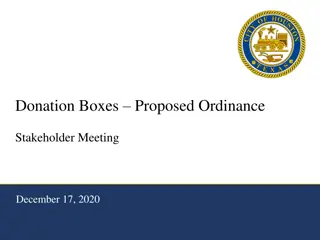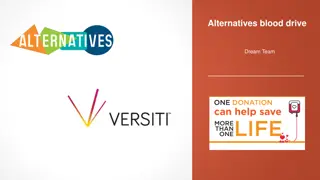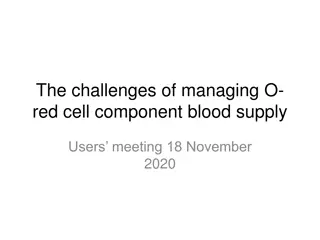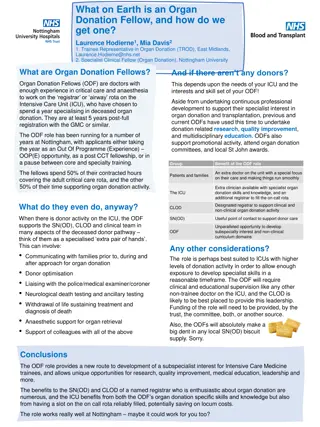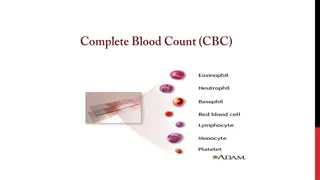Achieving 100% Voluntary Non-Remunerated Blood Donation in Oman
In the Sultanate of Oman, the Department of Blood Services has successfully moved towards 100% Voluntary Non-Remunerated Blood Donation (VNRBD), focusing on motivating the public to donate blood regularly. This shift has led to a significant increase in blood donations from 2007 to 2011, with a growth rate of 35.7% in VNRBD and a decline in family replacement donors. The approach involves strategic steps to raise awareness and encourage voluntary, anonymous blood donation.
Download Presentation

Please find below an Image/Link to download the presentation.
The content on the website is provided AS IS for your information and personal use only. It may not be sold, licensed, or shared on other websites without obtaining consent from the author.If you encounter any issues during the download, it is possible that the publisher has removed the file from their server.
You are allowed to download the files provided on this website for personal or commercial use, subject to the condition that they are used lawfully. All files are the property of their respective owners.
The content on the website is provided AS IS for your information and personal use only. It may not be sold, licensed, or shared on other websites without obtaining consent from the author.
E N D
Presentation Transcript
1 ISBT WP on Global Blood Safety Case Study 2020-1 Achieving 100% voluntary non- remunerated blood donation. The case of the Sultanate of Oman Thamina Ashraf and Cees Th. Smit Sibinga ISBT WP GBS 2020
Background 1975 WHA Resolution 28.72 encourages countries to promote development of voluntary non-remunerated blood donation (VNRBD), based on a nationally organized and regulated blood service. 2 ISBT WP GBS 2020
Background Oman Department of Blood Services (DBS) is the national blood bank/establishment and transfusion service. 1971 - To increase blood safety, paid donations were forbidden; but that is not enough. Acceptable VNRBD and selected replacement donations (family, relatives, acquaintances) 3 ISBT WP GBS 2020
Background DBS policy moving away from family/ replacement towards 100% VNRBD, increasing female donors. Strategy step by step motivating family/replacement donors and public to donate blood on a voluntary, non- remunerated, anonymous and regular basis. 4 ISBT WPGBS 2020
Background Turn of the Century change in the approach of public and still existing family/replacement (FR) donors. Project 2007-2011 increase of VNRBD m/f through improved public awareness activities; improved conversion of FR donors. 5 ISBT WP GBS 2020
2007-2011 Results Total blood donations have significantly increased with 15% from 2007 to 2011 (table 1) - 6 ISBT WP GBS 2020
Results 2007-2011 During this period -overall growth rate of VNRBD has been 35.7%; -sharp decline in family replacement donors (25% in 2007 to 11% in 2011). 7 RAG BD 2020
Table 1 donations 2007-2011 2007 2008 2009 2010 2011 VNRBD 13,026 16,153 17,555 18,534 20,378 FRD 4,957 4,715 Total 19,983 20,868 22,513 23,276 22,975 % FRD 24.8 22.6 4,958 4,742 2,597 22.0 20.4 10.8 8 RAG BD 2020
Results 2007-2011 Blood donations in the regional blood banks remained in par with the central collections. Additionally (figure 1 & 2) significant increase of female donors ( 56%). However, the proportion regular donors (54%) did not yet increase. 9 ISBT WP GBS 2020
10 RAG BD 2020
11 RAG BD 2020
What happened? Trend: gradual increase in voluntary donations, but significant reduction in replacement donors as majority of them were converted into regular volunteers. 12 RAG BD 2020
What happened? Significant factors that have influenced the motivation and retention of blood donors and the conversion of family replacement to voluntary donors include: Establishment of a national, centrally coordinated blood donor program (sustainably financed) 13 RAG BD 2020
What happened? Competent professionals with continuous education in donor handling and care Well-established donor data base (confidentiality) Follow up of deferred donors 14 RAG BD 2020
What happened? Continuous recognition of donors raising self-esteem and feeling of being respected Partnership with mass media Mass distribution educational material on blood donation especially in colleges and universities 15 RAG BD 2020
What happened? Reaching the public through daily blood mobile sessions Frequent communication (telephone, SMS, e-mail) reminding of next donation 16 RAG BD 2020
What happened? Recruitment of supporting volunteers from various charitable/non-charitable organizations and clubs. 17 RAG BD 2020
Table 2 - Results 2012-2018 2012 2013 2014 2015 2016 2017 2018 VNRB 23,287 22,387 25,076 22,555 23,562 22,278 25,305 FRD 1,637 3,697 3,533 3,514 4,607 2,992 2,035 Total 24,924 26,084 28,609 26,069 28,169 25,270 27,740 % FRD 6.6 14.6 12.3 13.5 16.4 9.1 8.8 Period 2007 2018 (11 years) Total increase Increase VNRBD Decrease FRD - 68.5% (Female 6.3%) + 138.8% + 194.3% (Female 12.0%) (Female 12.6%) 18 RAG BD 2020
Voluntary donors (DBS) 2012-2018 by gender 25000 22121 21267 20287 19392 19265 20000 18478 18477 15000 10000 4177 5000 3309 3184 3213 3170 3000 2910 0 2012 2013 2014 2015 2016 2017 2018 Voluntary Male Voluntary Female 19 RAG BD 2020
Voluntary donors (DBS) 2012-2018 by gender and % female donors 2012 2013 2014 2015 2016 2017 2018 VNR male 20,287 18,477 21,267 18,478 19,392 19,265 22,121 VNR female 3.000 2,910 3.309 4,177 3,170 3,213 3,184 Total 23,287 22,287 25,076 22,555 23,561 22,278 25,305 % female 12.8 12.9 13.2 18.5 13.5 14.4 12.6 20 RAG BD 2020
Family/replacement donors (DBS) 2012- 2018 by gender 4332 4500 4000 3457 3500 3269 3212 3000 2771 2500 2281 2000 1536 1500 1000 375 500 302 264 240 221 154 101 0 2012 2013 2014 2015 2016 2017 2018 21 RAG BD 2020 Famil Replacement Male Family Replacement Female
Family/replacement donors (DBS) 2012-2018 by gender and % female donors 2012 2013 2014 2015 2016 2017 2018 FRD male 1,536 3,457 3,269 3,212 4,332 2,771 2,281 FRD female 101 240 264 302 375 221 154 Total 1,637 3,697 3,533 3,514 4,607 2,992 2,435 % female 6.2 6.5 7.5 8.6 8.1 7.4 6.3 22 RAG BD 2020
Conclusion Motivation and retention of voluntary blood donors is the fundament of a safe, sufficient and sustainable blood supply. Continuous education and sensitization of the population is cornerstone in achieving this goal. 23 RAG BD 2020
Conclusion Continuous donor mobilization efforts have resulted in a significant increase in blood donation (2007-2011) as well as achieving 91.2% VNRBD. However, regular blood donation did not yet really improve. 24 RAG BD 2020
Conclusion Focus for the next period and beyond will be on retention of VNRBD to improve reliability and safety of the blood supply in Oman. 25 RAG BD 2020
Nothing is impossible! 26 Isbt wp gbs2020


